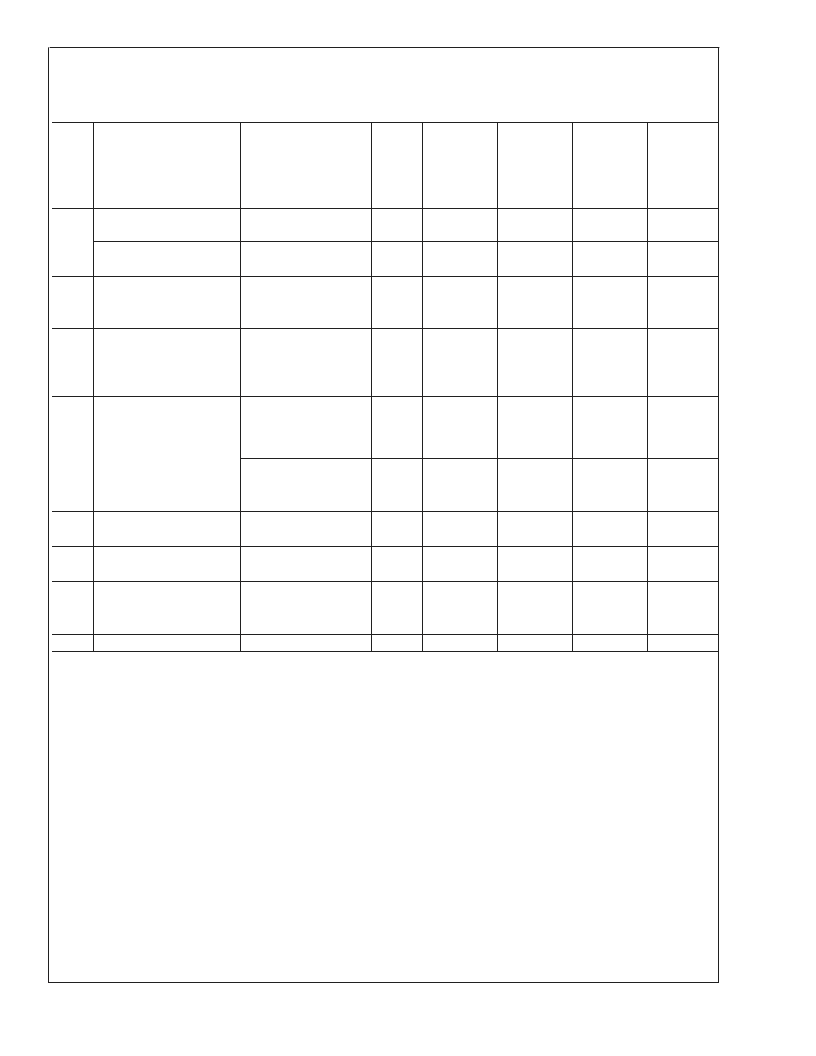- 您現(xiàn)在的位置:買賣IC網(wǎng) > PDF目錄358860 > LM4050BIM3X-8.2 (NATIONAL SEMICONDUCTOR CORP) Precision Micropower Shunt Voltage Reference PDF資料下載
參數(shù)資料
| 型號: | LM4050BIM3X-8.2 |
| 廠商: | NATIONAL SEMICONDUCTOR CORP |
| 元件分類: | 基準(zhǔn)電壓源/電流源 |
| 英文描述: | Precision Micropower Shunt Voltage Reference |
| 中文描述: | 1-OUTPUT TWO TERM VOLTAGE REFERENCE, 8.192 V, PDSO3 |
| 封裝: | 3 X 1.30 MM, PLASTIC, TO-236-AB, SOT-23, 3 PIN |
| 文件頁數(shù): | 7/14頁 |
| 文件大小: | 233K |
| 代理商: | LM4050BIM3X-8.2 |

LM4050-10.0
Electrical Characteristics (Industrial Temperature Range)
Boldface limits apply for T
= T
= T
MIN
to T
;
all other limits T
= T
= 25C. The grades A, B and C designate initial Re-
verse Breakdown Voltage tolerances of
0.1% and
±
0.2% and 0.5% respectively.
Symbol
Parameter
Conditions
Typical
(Note 5)
Units
(Limit)
LM4050AIM3 LM4050BIM3 LM4050CIM3
Limits
(Note 6)
Limits
(Note 6)
Limits
(Note 6)
V
R
Reverse Breakdown
Voltage
Reverse Breakdown
Voltage Tolerance (Note 7)
I
R
= 150 μA
10.00
V
I
R
= 150 μA
±
10
±
43
±
20
±
53
±
50
±
83
mV (max)
mV (max)
μA
μA (max)
μA (max)
ppm/C
ppm/C
ppm/C
(max)
mV
I
RMIN
Minimum Operating Current
80
100
103
100
103
100
103
V
R
/
T Average Reverse
Breakdown Voltage
Temperature Coefficient
(Note 7)
I
R
= 10 mA
I
R
= 1 mA
I
R
= 150 μA
±
40
±
20
±
20
±
50
±
50
±
50
V
R
/
I
R
Reverse Breakdown
Voltage Change with
Operating Current Change
(Note 8)
I
RMIN
≤
I
R
≤
1 mA
0.8
1.5
1.5
1.5
mV (max)
3.5
3.5
3.5
mV (max)
1 mA
≤
I
R
≤
15 mA
8.0
mV
12.0
23.0
12.0
23.0
12.0
23.0
mV (max)
mV (max)
Z
R
Reverse Dynamic
Impedance
I
R
= 1 mA, f = 120 Hz,
I
AC
= 0.1 I
R
I
R
= 150 μA
10 Hz
≤
f
≤
10 kHz
t = 1000 hrs
T = 25C
±
0.1C
I
R
= 150 μA
T = 40C to 125C
0.7
e
N
Wideband Noise
150
μV
rms
V
R
Reverse Breakdown
Voltage Long Term Stability
120
ppm
V
HYST
Output Hysteresis
2.8
mV
Note 1:
Absolute Maximum Ratings indicate limits beyond which damage to the device may occur. Operating Ratings indicate conditions for which the device is func-
tional, but do not guarantee specific performance limits. For guaranteed specifications and test conditions, see the Electrical Characteristics. The guaranteed speci-
fications apply only for the test conditions listed. Some performance characteristics may degrade when the device is not operated under the listed test conditions.
Note 2:
If parts are exposed to temperatures outside the specific operating temperature range, the output may shift due to hysteresis.
Note 3:
The maximum power dissipation must be derated at elevated temperatures and is dictated by T
(maximum junction temperature),
θ
JA
(junction to am-
bient thermal resistance), and T
(ambient temperature). The maximum allowable power dissipation at any temperature is PD
= (T
Jmax
T
A
)/
θ
JA
or the number
given in the Absolute Maximum Ratings, whichever is lower. For the LM4050, T
Jmax
= 125C, and the typical thermal resistance (
θ
JA
326C/W for the SSOT-23 package.
Note 4:
The human body model is a 100 pF capacitor discharged through a 1.5 k
resistor into each pin. The machine model is a 200 pF capacitor discharged di-
rectly into each pin.
Note 5:
Typicals are at T
J
= 25C and represent most likely parametric norm.
Note 6:
Limits are 100% production tested at 25C. Limits over temperature are guaranteed through correlation using Statistical Quality Control (SQC) methods. The
limits are used to calculate National’s AOQL.
Note 7:
The boldface (over-temperature) limit for Reverse Breakdown Voltage Tolerance is defined as the room temperature Reverse Breakdown Voltage Tolerance
±
[(
V
R
/
T)(max
T)(V
R
)]. Where,
V
R
/
T is the V
R
temperature coefficient, max
T is the maximum difference in temperature from the reference point of 25C to T
MIN
or T
MAX
, and V
R
is the reverse breakdown voltage. The total over-temperature tolerance for the different grades in the industrial temperature range where max
T
= 65C is shown below:
A-grade:
±
0.425% =
±
0.1%
±
50 ppm/C x 65C
B-grade:
±
0.525% =
±
0.2%
±
50 ppm/C x 65C
C-grade:
±
0.825% =
±
0.5%
±
50 ppm/C x 65C
Therefore, as an example, the A-grade LM4050-2.5 has an over-temperature Reverse Breakdown Voltage tolerance of
±
2.5V x 0.425% =
±
11 mV.
Note 8:
Load regulation is measured on pulse basis from no load to the specified load current. Output changes due to die temperature change must be taken into
account separately.
L
www.national.com
7
相關(guān)PDF資料 |
PDF描述 |
|---|---|
| LM4050CIM3X-8.2 | Precision Micropower Shunt Voltage Reference |
| LM4050AIM3-2.5 | Precision Micropower Shunt Voltage Reference |
| LM4050BIM3-2.5 | Precision Micropower Shunt Voltage Reference |
| LM4050CIM3-2.5 | Precision Micropower Shunt Voltage Reference |
| LM4050CEM3-2.5 | Precision Micropower Shunt Voltage Reference |
相關(guān)代理商/技術(shù)參數(shù) |
參數(shù)描述 |
|---|---|
| LM4050BIX3-2.1 | 制造商:Maxim Integrated Products 功能描述:50PPM/+C PRECISION MICROPOWER SHUNT - Rail/Tube |
| LM4050BIX3-2.1+ | 制造商:Maxim Integrated Products 功能描述:V-REF PRECISION 2.048V 15MA 3PIN SC-70 - Rail/Tube |
| LM4050BIX3-2.1+T | 制造商:Maxim Integrated Products 功能描述:V-REF PRECISION 2.048V 15MA 3PIN SC-70 - Tape and Reel |
| LM4050BIX3-2.1-T | 功能描述:基準(zhǔn)電壓& 基準(zhǔn)電流 RoHS:否 制造商:STMicroelectronics 產(chǎn)品:Voltage References 拓撲結(jié)構(gòu):Shunt References 參考類型:Programmable 輸出電壓:1.24 V to 18 V 初始準(zhǔn)確度:0.25 % 平均溫度系數(shù)(典型值):100 PPM / C 串聯(lián) VREF - 輸入電壓(最大值): 串聯(lián) VREF - 輸入電壓(最小值): 分流電流(最大值):60 mA 最大工作溫度:+ 125 C 封裝 / 箱體:SOT-23-3L 封裝:Reel |
| LM4050BIX3-2.5 | 制造商:Maxim Integrated Products 功能描述:50PPM/+C PRECISION MICROPOWER SHUNT - Rail/Tube 制造商:Rochester Electronics LLC 功能描述: |
發(fā)布緊急采購,3分鐘左右您將得到回復(fù)。